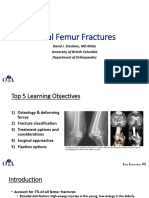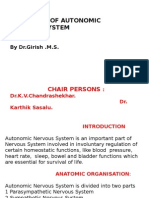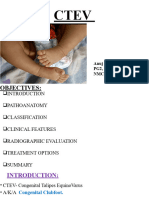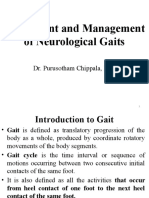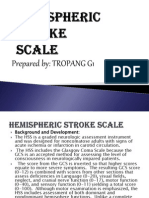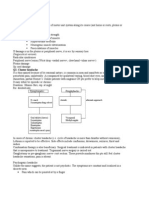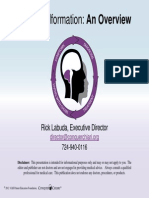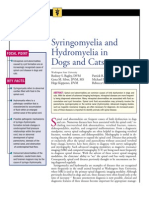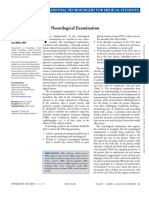100%(2)100% found this document useful (2 votes)
Syringomyelia
Syringomyelia
Uploaded by
Akash MarathakamIt is a disorder characterized by the presence of a cyst or cavity in the central part of spinal cord ,the cyst called as syrinx..
Copyright:
Attribution Non-Commercial (BY-NC)
Available Formats
Download as PPT, PDF or read online from Scribd
Download as ppt or pdf
Syringomyelia
Syringomyelia
Uploaded by
Akash Marathakam100%(2)100% found this document useful (2 votes)
It is a disorder characterized by the presence of a cyst or cavity in the central part of spinal cord ,the cyst called as syrinx..
Copyright
© Attribution Non-Commercial (BY-NC)
Available Formats
PPT, PDF or read online from Scribd
Share this document
Did you find this document useful?
Is this content inappropriate?
It is a disorder characterized by the presence of a cyst or cavity in the central part of spinal cord ,the cyst called as syrinx..
Copyright:
Attribution Non-Commercial (BY-NC)
Available Formats
Download as PPT, PDF or read online from Scribd
Download as ppt or pdf
100%(2)100% found this document useful (2 votes)
Syringomyelia
Syringomyelia
Uploaded by
Akash MarathakamIt is a disorder characterized by the presence of a cyst or cavity in the central part of spinal cord ,the cyst called as syrinx..
Copyright:
Attribution Non-Commercial (BY-NC)
Available Formats
Download as PPT, PDF or read online from Scribd
Download as ppt or pdf
You are on page 1/ 17
It is a disorder characterized by the presence
of a cyst or cavity in the central part of spinal
cord ,the cyst called as syrinx. When it affect
the brainstem, the condition is called
syringobulbia.
HISTORY
It usually progresses slowly .symptoms depend primarily on
the location of the lesion within the neuraxis. Clinical
manifestations include the following:
Sensory: Dissociated sensory loss
Motor: Damages the motor neurons & cause muscle
atrophy
Autonomic: Impaired bowel & bladder functions, sexual
dysfunction may develop in long-standing cases.
Extension of syrinx: A syrinx may extend in to medulla
producing syringobulbia
Other manifestations: painless ulcers, edema, neurogenic
arthropathies. Scoliosis is seen sometimes. Acute painful
enlargement of shoulder associated with destruction of
head of humerus.
PHYSICAL
Diminished arm reflexes
Lower limb spasticity, paraparesis, hyperreflexia,
Dissociated sensory impairment
Brainstem signs are common
The syrinx may extend in to the brainstem affecting cranial
nerves or cerebellar function
SYRINGOMYELIA WITH FOURTHVENTRICLE
COMMUNICATION.
DUE TO BLOCKAGE OF CSF CIRCULATION.
DUE TO SPINALCORD INJURY.
SYRINGOMYELIA & SPINAL DYSRAPHISM.
DUE TO INTRAMEDULLARY TUMORS.
IDIOPATHIC.
Estimated prevalence of disease is about 8.4 cases/100000
people.
SEX – More frequently in men than women
AGE – Usually beginning in young adulthood
1. ETIOLOGY ASSOCIATED WITH CRANIOVERTIBRAL
JUNCTION ABNORMALITIES:
a) Bony abnormalities.
b) Soft tissue masses of abnormal nature.
c) Cerebellar tonsils.
d) Chiari malformation.
e) Membranous abnormalities such as arachnoid cyst, vascularised
membranes.
2. ETIOLOGY NOT ASSOCIATED WITH
CRANIOVERTEBRAL JUNCTION
ABNORMALITIES
a)Arachnoid scarring related to spinal trauma.
b)Arachnoid scarring related to meningeal inflammation.
c)Arachnoid scarring related to surgical trauma.
d)Sub arachnoid space stenosis due to spinal neoplasm.
e)Idiopathic.
Patients may experience chronic pain, abnormal
sensations and loss of sensation particularly in hands. Syrinx
may also cause disruptions in parasympathetic and
sympathetic nervous system, leading to abnormal body
temperature or sweating, bowel control issues.
In case of syringobulbia, vocal cord paralysis, tongue
wasting, trigeminal nerve sensory loss. Rarely bladder stones
can occur .
NEUROSURGEON
PSYCHIATRIST
UROLOGIST
PHYSIOTHERAPIST
OCCUPATIONALTHERAPIST
RECREATIONALTHERAPIST
MAGNETIC RESONANCE IMAGING [MRI]
This will show the syrinx in the spine, or presence of a tumor.
ELECTROMYOGRAPHY [EMG]
This measures the muscle weakness.
COMPUTED AXIAL TOMOGRAPHY [CT]
Shows the presence of tumors.
MYELOGRAM
Syrinx seen as a thin light grey shape, inside the spinalcolumn
MEDICATIONS
NSAIDs – Ibuprofen[1200-1800mg po-6h]
Aspirin[325-650mg po -6h]
Naproxen, Indomethacin,Pioroxicam,
Mefenamicacid.
MUSCLE RELAXANTS
Methocarbamol[1.5gm po qid ]
SURGICAL CARE
Sub occipital cervical decompression
Laminectomy and Syringotomy
Shunts
Fourth ventriculostomy
Neuroendoscopic surgery
Percutaneous needle
Syringomyelia is a disorder in which a cyst or cavity
forms within the spinal cord. The exact pathophysiology
is unknown. It can be diagnosed by MRI, EMG, CT scan.
No medical treatment is given. Identifying the underline
cause of Syrinx formation is very important. The
management of pain due to Syringomyelia is best
accomplished by a multi-disciplinary approach.
Ppt Created by Subitha
You have downloaded this document from www.scribd.com/akashmarathakam
You might also like
- UKMLA and PLAB Exam - Neurology Notes Updated100% (1)UKMLA and PLAB Exam - Neurology Notes Updated41 pages
- Physiotherapy Strategies For Multiple SclerosisNo ratings yetPhysiotherapy Strategies For Multiple Sclerosis39 pages
- Sensory Examination For Physiotherapy Student - NeuroNo ratings yetSensory Examination For Physiotherapy Student - Neuro25 pages
- Disorders of Autonomic Nervous System: Chair PersonsNo ratings yetDisorders of Autonomic Nervous System: Chair Persons37 pages
- Pre and Post Operative Physiotherapy Management in Tendon Transfer of HandNo ratings yetPre and Post Operative Physiotherapy Management in Tendon Transfer of Hand59 pages
- Assessment and Management of Neurological Gaits: Dr. Purusotham Chippala, PHD0% (1)Assessment and Management of Neurological Gaits: Dr. Purusotham Chippala, PHD73 pages
- Physiotherapy in The Management of Diabetic Neuropathy FinalNo ratings yetPhysiotherapy in The Management of Diabetic Neuropathy Final43 pages
- General Neurological Assessment: Shemjaz Arakkal MNo ratings yetGeneral Neurological Assessment: Shemjaz Arakkal M54 pages
- Constraint Induced Movement Therapy CIMTNo ratings yetConstraint Induced Movement Therapy CIMT22 pages
- Examination of Coordination and BalanceNo ratings yetExamination of Coordination and Balance27 pages
- Physiotherapy Management For Copd: T.Sunilkumar0% (1)Physiotherapy Management For Copd: T.Sunilkumar10 pages
- Definition/Description: Types of SyringomyeliaNo ratings yetDefinition/Description: Types of Syringomyelia8 pages
- Q1.Flaccid Paresis: Diagnostical VariantsNo ratings yetQ1.Flaccid Paresis: Diagnostical Variants47 pages
- Total Quality Management and Cost of Quality100% (1)Total Quality Management and Cost of Quality67 pages
- (Certified) Reference Materials: Ioannis PapadakisNo ratings yet(Certified) Reference Materials: Ioannis Papadakis35 pages
- Accreditation or Certification For LaboratoriesNo ratings yetAccreditation or Certification For Laboratories57 pages
- Chiari Malformation: An Overview: Rick Labuda, Executive DirectorNo ratings yetChiari Malformation: An Overview: Rick Labuda, Executive Director18 pages
- C+F-Syringomyelia and Hydro My Elia in Dogs and CatsNo ratings yetC+F-Syringomyelia and Hydro My Elia in Dogs and Cats9 pages
- Scoliosis A Case Study in An Adolescent BoyNo ratings yetScoliosis A Case Study in An Adolescent Boy9 pages
- Syringomyelia, Arachnoiditis and SpasticityNo ratings yetSyringomyelia, Arachnoiditis and Spasticity53 pages
- GMFM (GMFM-66 & GMFM-88) User's Manual, 2nd editionFrom EverandGMFM (GMFM-66 & GMFM-88) User's Manual, 2nd edition
- Sensory Examination For Physiotherapy Student - NeuroSensory Examination For Physiotherapy Student - Neuro
- Disorders of Autonomic Nervous System: Chair PersonsDisorders of Autonomic Nervous System: Chair Persons
- Pre and Post Operative Physiotherapy Management in Tendon Transfer of HandPre and Post Operative Physiotherapy Management in Tendon Transfer of Hand
- Assessment and Management of Neurological Gaits: Dr. Purusotham Chippala, PHDAssessment and Management of Neurological Gaits: Dr. Purusotham Chippala, PHD
- Physiotherapy in The Management of Diabetic Neuropathy FinalPhysiotherapy in The Management of Diabetic Neuropathy Final
- General Neurological Assessment: Shemjaz Arakkal MGeneral Neurological Assessment: Shemjaz Arakkal M
- (Certified) Reference Materials: Ioannis Papadakis(Certified) Reference Materials: Ioannis Papadakis
- Chiari Malformation: An Overview: Rick Labuda, Executive DirectorChiari Malformation: An Overview: Rick Labuda, Executive Director
- C+F-Syringomyelia and Hydro My Elia in Dogs and CatsC+F-Syringomyelia and Hydro My Elia in Dogs and Cats
















